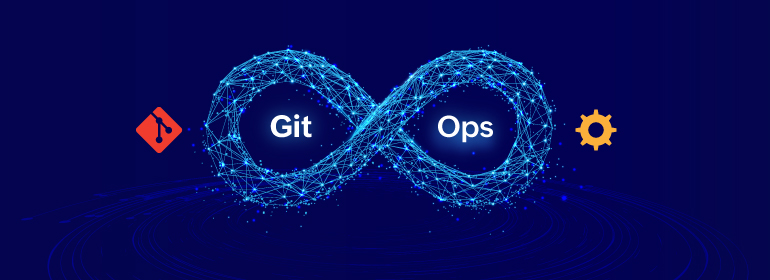Benefits of GitOps in IT app development
 Benefits of GitOps in IT monitoring
Benefits of GitOps in IT monitoringThe GitOps model has gained popularity as a software development approach. It enables IT teams to deliver higher-quality software faster and more efficiently.
By streamlining and automating the development process, GitOps provides substantial productivity improvements while ensuring comprehensive observability for monitoring and control.
This blog explores the concept of GitOps, its distinctions from DevOps, its functioning, and the benefits it offers to engineering professionals.
What is GitOps?
GitOps is a framework for IT operations based on best practices for DevOps. It is specifically designed to deploy and manage cloud-native IT infrastructure and applications. It derives its name from Git, a version control system widely used by developers.
When infrastructure is defined and deployed automatically using the principles of Infrastructure as Code (IaC) along with the Git practices of version control, seamless collaboration, and continuous integration and continuous delivery (CI/CD), it becomes GitOps.
DevOps vs. GitOps
While DevOps and GitOps share the goal of achieving efficient software development and deployment, they are distinct from each other. DevOps is a cultural approach that combines development and operations with standard tools for collaborative development, deployment, and iteration.
On the other hand, GitOps is a specific operational process that revolves around Git, the widely adopted revision control software. Git functions as a single source of truth and serves as a collaboration tool for creating, updating, branching, and merging nonlinear workflows.
GitOps should not be considered a subset of DevOps; instead, it is an independent process. Organizations can implement GitOps without adopting the entire DevOps culture, and vice versa.
How does GitOps work?
GitOps relies on the synchronization capabilities of the Git system to ensure consistency and robustness throughout the software development journey.
By establishing Git as the single source of truth from which a development pipeline emerges, GitOps enables declarative code at the source level, encompassing infrastructure, applications, and configurations. This code triggers an automated pipeline of tasks executed in sync with the source during runtime, ensuring synchronization across the entire IT team.
Why GitOps?
GitOps places developers at the center of IT development by leveraging familiar developer tools. By declaring the desired state of IT infrastructure at the code level, Git serves as the foundation for DevOps teams to ensure the seamless functioning of their CI/CD practices.
Many IaC tools, such as AWS CloudFormation, Terraform, Google Cloud Deployment Manager, Azure Resource Manager, Puppet, Chef, and Ansible, are in vogue. Alongside code commits in Git, these tools enable teams to automate their IT infrastructure's creation, management, and configuration, which can help increase efficiency, reduce costs, and improve security. IT teams may also choose their IaC tool based on their specific requirements.
Developers only need to update the repository, while the automated process handles the rest, like cruise control for application development. As a result, IT teams can build products faster and more efficiently, avoiding reconciliation mismatches and minimizing stress-filled troubleshooting.
Benefits of GitOps
- A unified approach: GitOps enables DevOps teams to establish and operate a single source of truth for infrastructure, core components, and the application stack.
- Faster deployments: GitOps significantly improves the deployment speed through automation, tighter feedback loops, better control systems, and the elimination of blind spots.
- Enhanced collaboration: Teams can work without scheduling conflicts, order discrepancies, or confusion in development stages, leading to highly functional teams.
- Robust compliance: GitOps provides a reliable way to implement and audit all compliance requirements, ensuring secure development processes.
- Added flexibility: GitOps can be applied to complex applications running in multiple cloud environments, containers, or hybrid setups, including on-premises deployments.
- Deeper observability: GitOps makes applications more transparent and observable, allowing for the effective monitoring of uptime, performance, and security.
How is GitOps done?
GitOps utilizes Git to store application, infrastructure, and configuration code as manifest files, covering the entire development-to-deployment process. The "Ops" in GitOps refers to YAML-based infrastructure configuration management and product features' CI/CD.
Typically, GitOps engineers write and push code to a Git repository such as GitHub, GitLab, or Bitbucket. They then containerize the deployment of features within a Kubernetes environment.
GitOps offers seamless communication, comprehensive visibility, enduring stability, and pervasive system reliability, benefiting IT professionals in developing, deploying, and maintaining various applications.
GitOps use cases
- Multi-cloud deployments: Orchestrating common workflows across public clouds and on-premises deployments
- Internet of Things deployments: Coordinating and controlling many endpoints while synchronizing metadata
- Automation of systems: Declaratively describing and observing systems with monitoring tools beyond just Kubernetes
- Cloud-native application development: Facilitating easy rollouts of new and existing application features
- Software pipeline building using familiar tools (Git): Fostering streamlined development, transparent workflows, robust security, and independent work cycles with a comprehensive audit trail
- Simplified IT infrastructure management: Reducing the risk of misconfigurations and enabling easier rollbacks to minimize human error and downtime
- Enhanced teamwork and resilience: Bringing diverse teams together across time zones and specializations while cementing the single source of truth
GitOps and monitoring
A GitOps workflow is comprised of four essential parts: a centralized code repository (Git), a CI/CD pipeline, an application deployment solution (e.g., Jenkins or GitLab), and a monitoring solution. Monitoring informs IT teams when something goes wrong, while observability empowers them to identify and rectify issues.
Comprehensive monitoring tools with in-depth observability, such as Site24x7, are crucial in supporting GitOps. IT teams can track deployment health, collect and analyze logs seamlessly, analyze traceroute for bottleneck identification, and visualize these insights from a single console. Comprehensive observability helps application development teams achieve a better mean time to resolution and improve overall customer satisfaction.
Adopting the GitOps approach in application development empowers IT teams to develop, deploy, monitor, and improve user experiences more efficiently. By leveraging Git and familiar developer tools, GitOps streamlines the software development process and significantly benefits engineering professionals.
Comments (0)